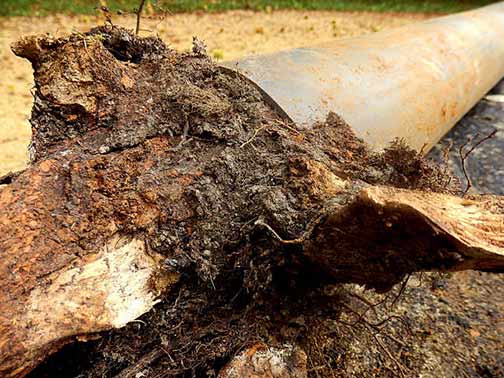
Your main sewer line is the large pipe that connects all the smaller drainpipes in your home to the city sewer lines, explains RedSail Management team. It is responsible for collecting all the wastewater generated from your home and moving it to the city’s wastewater management systems.
Because the main sewer line is inside the ground, it can present unique maintenance challenges for homeowners. Being underground means this vital piece of your home’s plumbing is subject to numerous natural and manmade threats.
One of the biggest threats to your main sewer line is tree roots. Tree roots can interfere with the function of your sewer line, dislodge it or even damage the pipes. Is there a way to keep tree roots from getting into and damaging your sewer line?
Why trees roots invade your sewer line and what to do about it
Tree roots usually penetrate and block a sewer line as plant roots search for nourishment around the sewer line. This problem is common where trees and shrubs with invasive root systems are planted close to the sewer line.
But most times, the real problem is not the presence of tree roots around the pipes. Tree roots can only detect the sewer line because of cracks in the sewer line that allow nutrient-rich water to seep into the surrounding soil.
With time tree roots can work their way into these cracks or loose joints and connections. Having entered the pipe, they grow very fast until they have completely blocked the water flow through the line.
How can you tell if there are tree roots in your sewer line? Since tree root intrusion can cause a sewer line to be blocked, the common signs of a clogged sewer line also indicate the presence of tree roots within the sewer line. These signs include:
- Multiple slow drains in your home
- Chronically blocked drains
- Sewage odors from drain openings and around the yard
- Increased presence of pests in and around the home
- Gurgling sound from the toilet each time you flush it
- Backed-up or overflowing toilets
- Soggy patches of soil and excessively green sections of lawn grass
While all of the above are signs of tree root invasion of a sewer line, the only way to be completely sure is to have your sewer line inspected. The best way to do this is by getting a professional plumber to perform a sewer camera inspection.
How to prevent or fix tree root invasion of your sewer line
Remove the trees
The best way to deal with this problem is to remove the trees or shrubs causing the problem. However, given the aesthetic impact of trees on your home and the health benefits they provide, this is not an option that many homeowners are willing to explore.
Replace problem trees
A similar but less radical option is to replace invasive plants with less invasive ones. Examples of trees with invasive root systems that can damage your sewer line include ash, oak, willow, sweetgum, basswood, sycamore or red, sugar, Norway and silver maples.
These trees should be planted far away from sewer pipes and underground utility lines. You can replace them with small, slow-growing trees or the less-destructive species; Amur maple, Japanese maple, dogwood, redbud, and fringetree.
Apply root killers
A third option is to leave the existing tree in place while curbing its ability to spread its roots to the location of your sewer line. To do this you will need root killers. These can be natural or chemical root killers. Available options include:
- Rock salt will kill the roots inside your sewer line without harming the tree or environment.
- Foaming root killer is specifically created to help remove tree roots from sewer lines. It is readily available in stores.
- Copper sulfate is highly effective for ridding tree roots in underground pipes. However, due to its toxicity to humans and animals, it is banned in some locations.
Physical barriers
This solution works best when combined with root killers. Physical barriers can be made of metal, wood or plastic and placed inside the ground between the plant and the sewer line. These barriers are used to redirect tree roots away from the sewer line.
Lastly, what can you do if you already have tree roots inside your sewer line? To solve the problem you will need to remove the tree roots and also close the leaks in the sewer line that are allowing tree roots to find their way into the pipe.
The best way to remove tree roots is by hydro-jetting your sewer line. This innovative drain-cleaning method will not only remove tree roots but also clear debris from your sewer line. To fix the leaks and cracks in the sewer line you may need to reline the pipes.
For more detailed guidance on how to solve this problem and prevent future issues with tree roots, you may want to talk to our experts.


